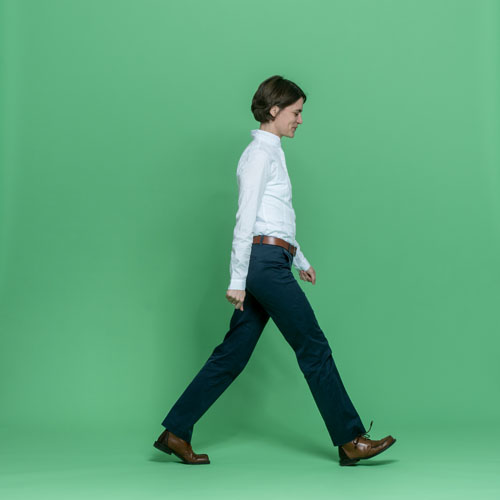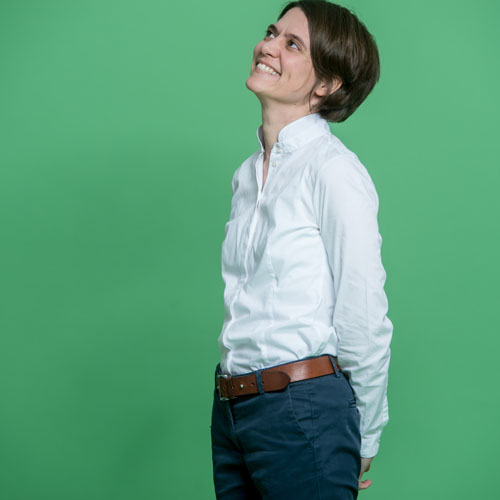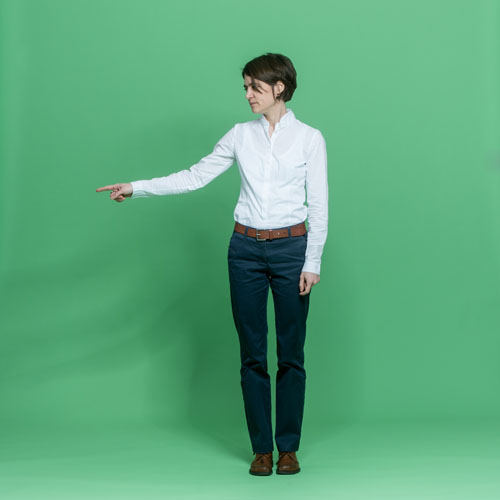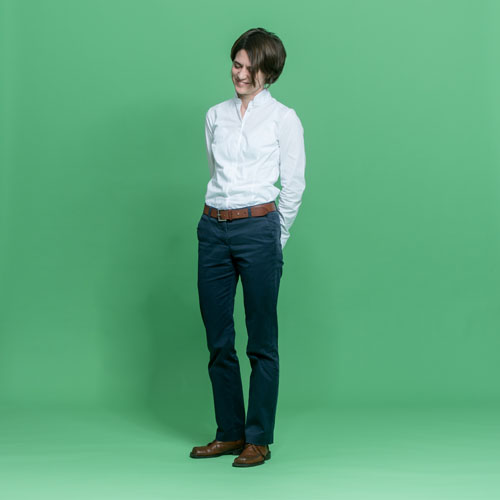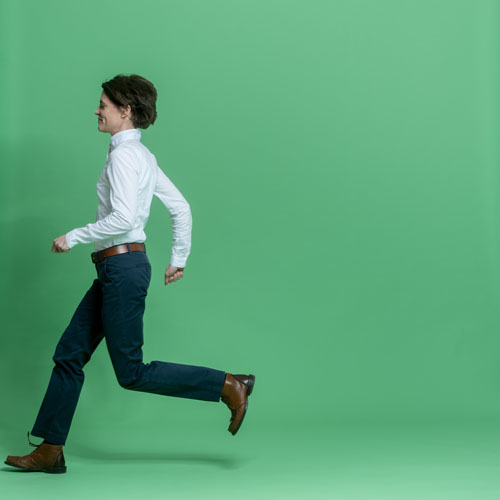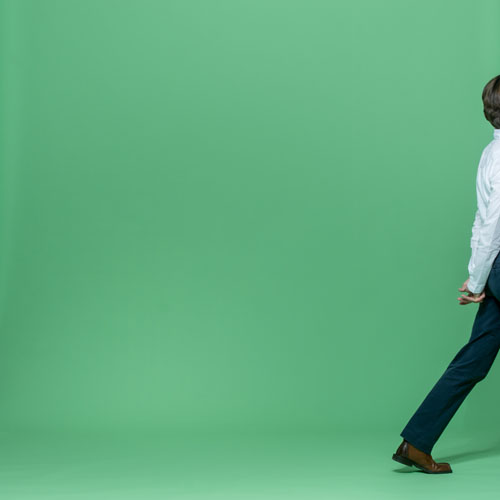Issue 9 / March 2014
The Chicken Egg is a Problem! Or: How Formlessness Creates Forms
Katharina Teutsch
Janina Wellmann takes on the pictorial depiction of emergent life
As a university student in Berlin and Paris, the historian Janina Wellmann immersed herself in the intellectual history of the Enlightenment. In a century that had scholars traveling back and forth across Europe, extending invitations to one another, where their ideas were dispatched around the world through letters, pictures and herbariums, where books were translated, praised and panned – against this historical backdrop, it is not easy to answer apparently simple questions like: "What was known and by whom in the year 1800?" or "How did this knowledge travel from one country and language to the next?"
Wellmann wrote her master’s thesis (under the supervision of Wolfgang Hardtwig) on the history of the reception of the Romantic natural philosophy of Lorenz Okens in France, and in so doing she investigated exactly this transfer of ideas. Her doctoral dissertation also explored how thoughts and ideas migrated historically, but this time between text and images; or more precisely put, how knowledge is constituted in text and images, above all when it is produced in abundance, and furthermore in one of the most important books of the Enlightenment – the Encyclopédie of Diderot und d’Alembert.
As a doctoral candidate at the newly founded Max Planck Institute for the History of Science, in the section led by Hans-Jörg Rheinberger, her own thoughts soon began to migrate and seek out a new object of study – the discipline of embryology, which was newly emergent around 1800. It was through a study of the use of of pictures in the rising science of biology that Wellmann sought to learn how natural history conceived the development of an organism at this time.
Katharina Teutsch: During your studies you also worked on eighteenth-century French intellectual history. But you soon found yourself not only interested in the question as to what was concretely known at this time but how the knowledge was disseminated and transformed transnationally. How was science and scholarship practiced back then?
Janina Wellmann: Until 1800 the main agenda was collecting and cataloguing nature’s data. The point was to first record nature’s inventory and impose a certain order on it.
KT: And then about the year 1800 something new emerged?
JW: The period around 1800 is perceived by historians as a so-called saddle period – a time when people’s conception of the world fundamentally changed – and part and parcel of this was a new interpretation of history. Everything that existed now had a certain genesis that made it into what it was. But it also meant something else. Notions such as “revolution” or “progress” – which the historian Reinhart Koselleck, who also coined the term saddle period, called “movement concepts” – described the present opening itself up to the future. Natural history was a part of this movement; in other words, nature was now carving out its own history.
KT: It was during this period that biology emerged as a life science. In your dissertation you examined the origins of embryology – its title was “The Form of Becoming” and the more specific subtitle reads “A Cultural History of Embryology 1760-1830”. Why are you working on this?
JW: Embryology is the science of becoming par excellence. In observing embryos one cannot escape the question as to what precisely happens over the course of time and how this might be apprehended. A simple explanation for development is that things obviously change and these changes proceed during a progressing time frame in a step-by-step fashion. What I wanted to find out was whether that was then in fact the explanation provided.
KT: And was that explanation indeed sufficient?
JW: I assert that it was about something else. Thinking about development circa 1800 meant to apprehend a highly functional structure, namely the organism, but one – and this is crucial – that permanently changes, one that is never the same. A system that is constantly being faced with its own dissolution, if you will.
KT: Give us an example.
JW: Development of an organism like a chicken egg – and that was the main object of research in the eighteenth and early nineteenth centuries – lasts some three weeks and can be observed in real time. The question as to what happens in this egg was no longer a purely philosophical question but one of observation. And what you see in a chicken egg is at first nothing more than a completely unstructured and fluid mass.
KT: And how did one deal with this formlessness?
JW: The first real dispute over development which was informed by observations was that between Caspar Friedrich Wolff and Albrecht von Haller in the last third of the eighteenth century. Both undertook observations of chicken embryos. Haller, likely the most famous anatomist and physiologist of the eighteenth century, had arrived at the conclusion that the structures which we see developing bit by bit in the egg had always been there but for a long time had been too small to be seen even with assistance of a microscope. Caspar Friedrich Wolff, at the time an unknown doctoral candidate, rejected this notion on the basis that it was not a question of what we can see – since in the beginning what we’re looking for simply doesn’t exist. In my book I have attempted to explain this debate by also addressing the role that pictures had in it. For in their writings, notes and correspondence both Haller and Wolff used pictures to explicate their respective approaches – namely that something new emerges; or that it was always there to begin with.
KT: So your agenda was not to retroactively settle this debate but to see what aids they employed to buttress their theses?
JW: I wouldn’t say that pictures are aids. There have always been philosophical discussions about development. But the moment you start to observe systematically this changes. You have to reconcile yourself to the fact that in the first stages of embryonic development you are basically unable to see anything. It is more about the duality of that which you observe and how you actually make exactly that intelligible. The epistemologist Gaston Bachelard called it the fusion of the picturesque and the intelligible.
KT: So if the pictures are not aids then are they instruments of knowledge?
JW: Yes, the drawing, the picture itself, is a form of knowledge. Haller and Wolff, in their different ways of using pictures, are great examples of this because they were both investigating chicken embryos but didn’t see the same thing. While Haller, in his own investigations, worked with drawings by Marcello Malpighis that were over a hundred years old, Wolff in his writings substituted the pictures for text to make his arguments.
KT: It might sound heretical, but is it not an almost banal finding that natural scientists availed themselves of drawings and schemata - that they worked by way of visualization? Darwin did it as well as Fabre and of course all the entymologists.
JW: For a very long time the common currency of scholarship was texts, but there then came a recognition that science had engendered a world of pictures that was not just handmaiden to the texts. The interest generated and insight gained from looking at these pictures of course always depends on the discipline that you are pursuing, the questions you are posing, and what the pictures are in fact supposed to elucidate.
KT: And posing my question a bit more concisely – what can the case of chicken embryos tell us about the picture praxis of researchers?
JW: The chicken egg is a problem! When at first you can only see a transparent fluid in chicken embryos then how can you actually recognize that something in it will become something, and how does one then describe this emergence of structures?
KT: How does one?
JW: By way of a new form of depiction, and in this case through a series of pictures. It is this form which allows for the step-by-step depiction of changes in the organism. And added to this was a new observational praxis.
KT: You mean to say that chicken embryos hadn’t always been observed the same way?
JW: In the seventeenth century Malpighi opened a chicken egg at a certain point and then described its development at precisely this point in time. At start of the nineteenth century something new occurred – through the use of incubators one now had the possibility of incubating hundreds of eggs simultaneously, of opening them up and comparing them. There was now so much illustrative material, so to speak, that one could juxtapose the various developmental stages of chicken eggs with one another. And that is precisely what the series of pictures accomplishes. It is exclusively a relation between images, meaning it hearkens to the question: How do these pictures relate to one another? And simultaneously, that which I do not see, namely the gaps between the pictures, is as important as the pictures themselves. Placing two pictures in relation to one another only makes sense against the background of everything that has been left out between them.
KT: So pictures of chicken embryos were placed in relation to one another and thereby enabled some idea of development. But how then exactly are we to understand the development from fertilized egg to hatchling? And the formation of organs at entirely different points in time? For this you use an epistemic category that you call “rhythmic episteme.” What are we to understand by this and how does it facilitate our insight and knowledge?
JW: The way I use the word “rhythm” is the image with which it was possible circa 1800 to describe development as not only something that happens through time but which is itself an “ordering” of time – rhythm as a figure that unifies repetition and variation, and it is in this way that it develops the new on the basis of what already exists. For the chick this means that not every organ is individually formed but that rudimentary organ systems first emerge and then gradually distinguish themselves as individual organs through ever greater differentiation.
KT: When such research fastens on organic life-models does not the danger loom large that one will conflate exact science with art?
JW: Generally speaking, “rhythm” is considered a Modernist phenomenon circa 1900 – the art of a Paul Klee, the vitalistic philosophy of a Ludwig Klages, the rhythmic gymnastics of Émile Jaques-Dalcroze. I want to show that a hundred years previous there had already been this intense preoccupation with rhythm and that at the time the “rhythmic episteme” is a fundament of both art and science – before the division into humanities and the natural sciences. The interesting thing about this concept of rhythm is that it is a kind of last attempt to ascribe the same creative principle to the products of nature as had been attributed to those of art.
KT: That would seem to be very close to the ancient idea of rhythm.
JW: For Plato, rhythm was a social moment in organizing the body politic, since a wide variety of individuals could come together in an ordered and consonous measure. At the same time in Greek for example, language itself is an extension of the body. Take for instance the metrical foot in poetry – podos – which is closely connected to physiological rhythms, to rhythms of the body.
KT: Isn’t scientific knowledge produced in the same “rhythmic” fashion?
JW: As a figure of knowledge the interesting aspect of rhythm is this connection between that which exists and that which doesn’t yet exist, between the past and a blueprint for the future. Rhythm brings these together because it is both a sequence and a discontinuity which can change at any moment. That makes rhythm an interesting figure when thinking about science, for science functions pretty much exactly as the British mathematician and philosopher Alfred North Whitehead once described rhythm: “The essence of rhythm is the fusion of sameness and novelty; so that the whole never loses the essential unity of the pattern, while the parts exhibit the contrast arising from the novelty of their detail.”
More on: Janina Wellmann
Images: © Maurice Weiss
